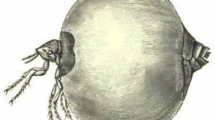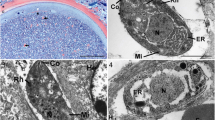Abstract
Tungiasis is caused by the penetration of the female sand flea Tunga penetrans into the skin of its host. This parasitic skin disease is almost invariably associated with an intense inflammation around embedded fleas, the underlying mechanisms being unknown. A study was undertaken to determine whether Wistar rats can be used as an animal model to assess cytokine kinetics during the natural course of the infection. Laboratory-raised Wistar rats were exposed in cages put on the soil in an area with high human attack rates. Rats were examined daily and blood samples were taken before exposure and at 2, 6, 10, 13, 16 and 20 days after flea penetration. TNF-α, IL-1β, IFN-γ, IL-4, IL-10 and CINC (a rat cytokine- induced neutrophil chemoattractant and member of the IL-8 family) were determined by enzyme immunoassay. The results showed an increasing serum concentration of TNF-α and IL-1β 10–13 days after penetration and a rapid increase in IL-4 2 days after fleas became embedded. During the natural course of the infection, the ratio of the serum concentration of TNF-α to that of IL-10 decreased, indicating a relative increase in the secretion of the anti-inflammatory cytokine. The treatment of lesions with silicone oil abrogated the natural disease course and changed the pattern of cytokine secretion. We conclude that the Wistar rat is an appropriate model to study immune responses in tungiasis.


Similar content being viewed by others
References
Arlian LG, Vyszenski-Moher DL, Rapp CM, Hull BE (1996) Production of IL-1 alpha and IL-1 beta by human skin equivalents parasitized by Sarcoptes scabiei. J Parasitol 82: 719–723
Arlian LG, Morgan MS, Neal JS (2004) Extracts of scabies mites (Sarcoptidae: Sarcoptes scabiei) modulate cytokine expression by human peripheral blood mononuclear cells and dendritic cells. J Med Entomol 41:69–73
Bourreau E, Prevot G, Gardon J, Pradinaud R, Launois P (2001) High intralesional interleukin-10 messenger RNA expression in localized cutaneous leishmaniasis is associated with unresponsiveness to treatment. J Infect Dis 184:1628–1630
Egan PJ, Kimpton W, Seow HF, Bowles VM, Brandon MR, Nash AD (1996) Inflammation-induced changes in the phenotype and cytokine profile of cells migrating through skin and afferent lymph. Immunology 89:539–546
Eisele M, Heukelbach J, Van Marck E, Mehlhorn H, Meckes O, Franck S, Feldmeier H (2003) Investigations on the biology, epidemiology, pathology and control of Tunga penetrans in Brazil: I. Natural history of tungiasis in man. Parasitol Res 90:87–99
Elhay MJ, Hanrahan CF, Bowles VM, Seow HF, Andrews AE, Nash AD (1994) Cytokine mRNA expression in skin in response to ectoparasite infection. Parasite Immunol 16:451–461
Feldmeier H, Heukelbach J, Eisele M, Sousa AQ, Barbosa LM, Carvalho CB (2002) Bacterial superinfection in human tungiasis. Trop Med Int Health 7:559–564
Feldmeier H, Eisele M, Saboia-Moura RC, Heukelbach J (2003a) Severe tungiasis in underprivileged communities: case series from Brazil. Emerg Infect Dis 9:949–955
Feldmeier H, Heukelbach J, Eisele M, Ribeiro R, Harms G, Mehlhorn H, Liesenfeld O (2003b) Investigations on the biology, epidemiology, pathology and control of Tunga penetrans in Brazil: III. Cytokine levels in peripheral blood of infected humans. Parasitol Res 91:298–303
Feldmeier H, Eisele M, Van Marck E, et al (2004) Investigations of the biology, epidemiology, pathology and control of Tunga penetrans in Brazil: IV. Clinical and histopathology. Parasitol Res DOI 10.1007/s00436-004-1197-2
Heukelbach J, Oliveira FA de, Hesse G, Feldmeier H (2001) Tungiasis: a neglected health problem of poor communities. Trop Med Int Health 6:267–272
Heukelbach J, Franck S, Feldmeier H (2004a) High attack rate of Tunga penetrans (Linnaeus 1758) infestation in an impoverished Brazilian community. Trans R Soc Trop Med Hyg 98:431–434
Heukelbach J, Winter B, Wilcke T, et al (2004b) Selective mass treatment with ivermectin to control intestinal helminthiases and parasitic skin diseases in a severely affected population. Bull WHO 82:563–571
Heukelbach J, Bonow I, Witt L, et al (2004c) High infection rate of Wolbachia endobacteria in the sand flea Tunga penetrans from Brazil. Acta Tropica (in press)
Iida M, Watanabe K, Tsurufuji M, Takaishi K, Iizuka Y, Tsurufuji S (1992) Level of neutrophil chemotactic factor CINC/gro, a member of the interleukin-8 family, associated with lipopolysaccharide-induced inflammation in rats. Infect Immun 60:1268–1272
Otranto D (2001) The immunology of myiasis: parasite survival and host defense strategies. Trends Parasitol 17:176–182
Saint Andre A, Blackwell NM, Hall LR, et al (2002) The role of endosymbiotic Wolbachia bacteria in the pathogenesis of river blindness. Science 295:1892–1895
Sato Y, Ohshima T (2000) The expression of mRNA of proinflammatory cytokines during skin wound healing in mice: a preliminary study for forensic wound age estimation (II). Int J Legal Med 113:140–145
Tani K, Morimoto M, Hayashi T, Inokuma H, Ohnishi T, Hayashiya S, Nomura T, Une S, Nakaichi M, Taura Y (2002) Evaluation of cytokine messenger RNA expression in peripheral blood mononuclear cells from dogs with canine demodicosis. J Vet Med Sci 64:513–518
Watanabe K, Koizumi F, Kurashige Y, Tsurufuji S, Nakagawa H (1991) Rat CINC, a member of the interleukin-8 family, is a neutrophil-specific chemoattractant in vivo. Exp Mol Pathol 55:30–37
Wikel SK, Alarcon-Chaidez FJ (2001) Progress toward molecular characterization of ectoparasite modulation of host immunity. Vet Parasitol 101:275–287
Acknowledgements
This study was partly supported by the World Health Organization (Geneva, Switzerland) and the PROBRAL CAPES/DAAD academic exchange program. The data are part of a medical thesis by L.-H.W. The secretarial assistance of Michi Feldmeier and the technical assistance of Solvy Wolcke are gratefully acknowledged.
Author information
Authors and Affiliations
Corresponding author
Rights and permissions
About this article
Cite this article
Feldmeier, H., Witt, LH., Schwalfenberg, S. et al. Investigations on the biology, epidemiology, pathology and control of Tunga penetrans in Brazil. V. Cytokine concentrations in experimentally infected Wistar rats. Parasitol Res 94, 371–376 (2004). https://doi.org/10.1007/s00436-004-1219-0
Received:
Accepted:
Published:
Issue Date:
DOI: https://doi.org/10.1007/s00436-004-1219-0




